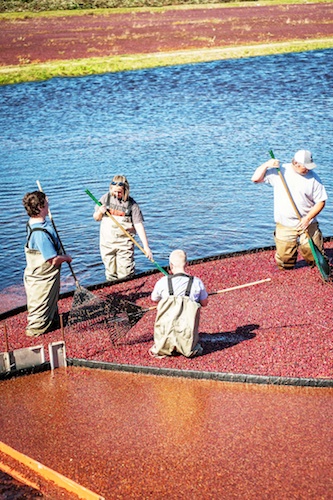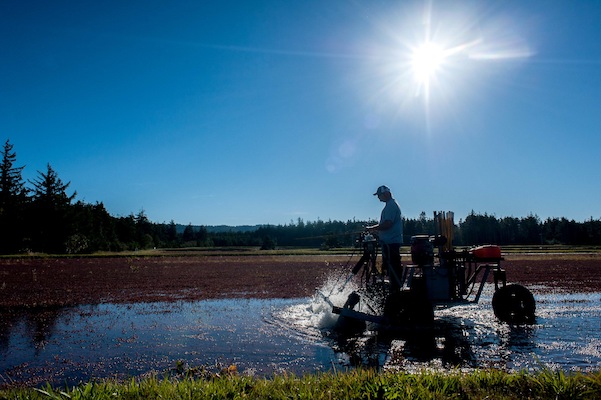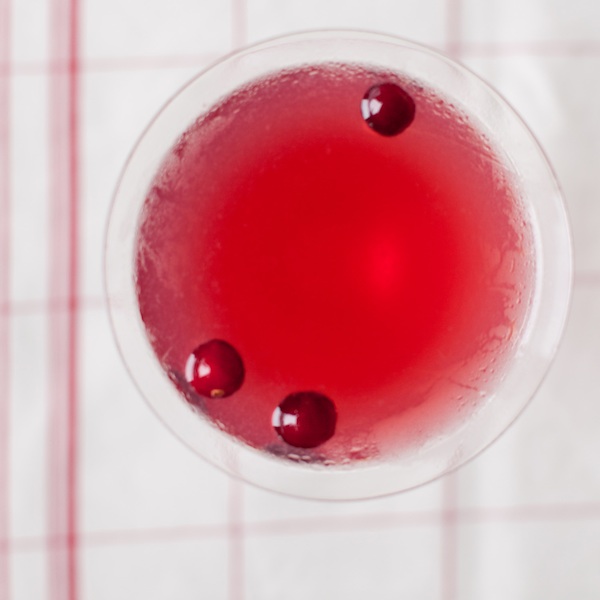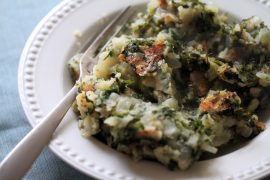LONG BEFORE CRANBERRY JUICE became a staple on supermarket shelves, cranberry farming was a part-time job that Oregon Coast families took up to supplement their incomes.
“Mill workers, fishermen—a lot of them had cranberry farms,” says Ty Vincent, a farmer at Vincent Family Cranberries. “It was a sideline, and it was fresh fruit only. A lot of them hand-picked the berries and sold them around the holidays.”
Local lore traces the early cranberries to several Massachusetts transplants, including Charles Dexter McFarlin, who established a small bog near Coos Bay in 1885.
In the Vincent family, cranberry farming began with Elmer Robison in 1957, when he bought a few acres in Port Orford. Twenty years later, Robison’s son-in-law, Bill Vincent, saw the tide turning against the once-lucrative salmon fishery and traded his trawler for acreage and bogs in Bandon. His sons Ty and Tim make up a third generation in the cranberry bogs.
Vincent’s timing couldn’t have been more fortuitous. Ocean Spray had begun the big push of cranberry juice blends, and demand for berries rocketed—as did the price from about 20 cents to 60 cents per pound.
Today the Vincent family has sixty-two acres within shouting distance of the Pacific Ocean. Twenty-three of those acres are home to the fifteen bogs that produce the boutique products bearing the independent Vincent brand.
“You can’t make a living off of cranberries unless you are really big and automated,” says Tim Vincent, who handles marketing for the business. Along the Oregon Coast, where the land is wild and the farming parcels smaller, large-scale farming is nearly impossible. Like the mill workers and fishermen before them, the brothers have second jobs in other industries.
The moderate coastal climate, however, gives Oregon farmers the advantage of a growing season that is six to eight weeks longer than the farms farther east. Those extra weeks make for a riper, fuller berry. “The riper they are, the more naturally nutritious a cranberry is,” Tim says.
The cranberry growing season here begins in March when the buds awaken and the vines start to grow. Once the bud breaks, they develop the hooks from which their name is derived.
“The hooks are little and red—they look like the beak of a crane,” Ty notes. “That’s why they are called cranberries.”
They bloom until mid-June, then the berries remain on the vine until they are mature and ready for harvest. Cranberry harvest on most farms in Oregon begins the first of October and lasts into the middle of November, says Ty. At the Vincent farm, they generally start late in October and continue the harvest until Thanksgiving. “We’re usually one of the last growers done,” says Ty. The Vincents believe that the later they let the berries ripen, the better the juice.
“You get a berry that is at a different stage of ripeness,” says Scott Soares, executive director of the U.S. Cranberry Marketing Committee, based in Massachusetts. “Like any fruit, when it gets ripe, the sugar content goes up. It’s just a fact of fruit ripening. The brix—the measure of natural sugar—is higher in fruit that ripens longer. But the difference is small.”
Though Kay and Bill Vincent are retired, harvesting is a family affair. “If they are cold, I make them stop and come in and get hot chocolate,” she says of her family. Even the youngest, Natalie, 12, dons waders to help gather berries after they are knocked from the vine with a bog beater. Once the berries are harvested, it’s the job of Tim and his wife, Dani, to get the word out about their boutique berries.

“What we are working to do is to create this brand that takes the value of the Oregon cranberry and presents it directly to the consumer,” says Tim. “We want to highlight the difference between Oregon cranberries and cranberries from somewhere else.” Vincent cranberries have made it into New Seasons and Whole Foods markets, Nike and Intel campuses and a smattering of regional restaurants.
Today, Oregon is home to 215 cranberry farms, according to Soares. These farms harvest roughly 2,800 acres of cranberry bogs for about 403,000 barrels—each weighing 100 pounds. That’s about 5 percent of the domestic crop, which reached 7.9 million barrels in 2012. Soares would not say how many of those farms are part of the Ocean Spray coop, but Ty Vincent believes that about 60 percent of Oregon cranberry farms are with Ocean Spray with the remaining 40 percent being independent growers.
Cranberry farming on Oregon’s coast is no easy task. There’s the wind and rain—never more abundant than during harvest. Equipment must be custom fabricated, and the going rate today has dropped to about 25 cents per pound. The Vincents make the process more difficult by avoiding the use of herbicides and pesticides, and embracing organic products as much as possible. Their efforts don’t go unappreciated.
Jeffrey Morganthaler, bar manager at Portland’s Clyde Common, favors the Vincent cranberries for the bar’s specialty tequila cocktail, while Jenn Louis, chef and owner of Lincoln Restaurant, Sunshine Tavern and Culinary Artistry in Portland likes the berries for recipes such as her cranberry upside-down cake.
“My biggest objective in choosing the food we work with is that I want it to be really flavorful,” says Louis. “The Vincent cranberry farm is close to Portland, and it’s small. With small farms, there is more attention to how they raise their crops, how they farm and the quality of product that comes out. When we feed that product to our guests, they can taste that.”
|
Lincoln Restaurant Portland | lincolnpdx.com Chef Jenn Louis Cranberry Upside-Down Cake Makes one 9-inch cake | total time: 1 hour 30 minutes For topping: 4 tablespoons butter ¾ cup brown sugar, packed 9 ounces fresh cranberries (approx. 1 heaping cup) 4 ounces butter ¼ cup orange juice For batter: 1 ½ cups flour 2 teaspoons baking powder ¼ teaspoon salt 8 tablespoons butter, at room temperature 1 cup sugar 2 teaspoons vanilla 2 eggs, separate yolks and whites, reserve both ½ cup whole milk Juice of 1 medium orange ¼ teaspoon cream of tartar
|
|










Excellent article! People need to be educated as to the health benefits of Vincent Family
Cranberries. All other cranberry juices have added white sugar and other sweet juices to
make the cranberry more drinkable. The Vincent family have found a way to make their
juice with natural sweetness. Congratulations to the Vincent family for this important gift.
Thank you for sharing this information.